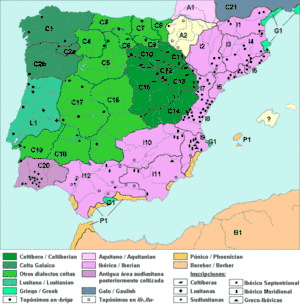阿基坦语
阿基坦語,是古阿基坦民族的語言,在被罗马征服前的中世纪早期或者更晚的这一段时间,古阿基坦地区所使用的的语言。该地区位于比利牛斯山脉和加龙河之间,后来被称作加斯科涅。
| 阿基坦語 | |
|---|---|
| 母语国家和地区 | 法國、西班牙 |
| 区域 | 庇里牛斯山以西 |
| 語言滅亡 | 中世纪早期 |
| 語系 | 瓦斯科尼亞語系 |
| 語言代碼 | |
| ISO 639-3 | xaq |

公元前200年,古西班牙語系的景況。(阿基坦語 A1-A2)
與其他語言的關係
阿基坦語的大部分專有名詞都與巴斯克語明顯同源, 見下表:
| 阿基坦語 | 原始巴斯克語 | 巴斯克語 | 巴斯克語詞意 |
|---|---|---|---|
| adin | *adiN | adin | 年齡,判斷力 |
| andere, er(h)e | *andere | andre | 夫人,女人 |
| andos(s), andox | *andoś | 主 | |
| arix | *aris | aritz | 橡樹 |
| artahe, artehe | *artehe | arte | 冬青橡木 |
| atta | *aTa | aita | 父親 |
| belex | ?*beLe | bele | 烏鴉 |
| bels | *bels | beltz | 黑色 |
| bihox, bihos | *bihos | bihotz | 心 |
| bon, -pon | *boN | on | 很好 |
| bors | *bors | bortz | 五 |
| cis(s)on, gison | *gisoN | gizon | 男人 |
| -c(c)o | *-Ko | -ko | 指小後綴 |
| corri, gorri | *goRi | gorri | 紅色 |
| hals- | *hals | haltza | 歲 |
| han(n)a | ?*aNane | anaia | 兄弟 |
| har-, -ar | *aR | ar | 男性 |
| hars- | *hars | hartz | 承擔 |
| heraus- | *herauś | herauts | 公豬 |
| il(l)un, ilur | *iLun | il(h)un | 黑暗 |
| leher | *leheR | leher | 松樹 |
| nescato | *neśka | neska, neskato | 女孩,年輕女子 |
| ombe, umme | *unbe | ume | 孩子 |
| oxson, osson | *otso | otso | 狼 |
| sahar | *sahaR | zahar | 年老 |
| sembe | *senbe | seme | 兒子 |
| seni | *śeni | sein | 男孩 |
| -ten | *-teN | -ten | 指小後綴 (固定式) |
| -t(t)o | *-To | -t(t)o | 指小後綴 |
| -x(s)o | *-tso | -txo,-txu | 指小後綴 |
喬奎因-一位瓦斯科尼亞語系學者就著有諸多關於阿基坦語的著作,米切萊納曾指出一些伊比利語的專有名詞與阿基坦語有諸多的相似性
,特别是專有名稱:
| 伊比利語 | 阿基坦語 |
|---|---|
| atin | adin |
| ata | atta |
| baiser | baese-, bais- |
| beleś | belex |
| bels | bels |
| boś | box |
| lauŕ | laur |
| talsku | talsco/ HALSCO |
| taŕ | t(h)ar / HAR |
| tautin | tautinn / hauten |
| tetel | tetel |
| uŕke | urcha |
延伸閱讀
- Ballester, Xaverio (2001): "La adfinitas de las lenguas aquitana e ibérica", Palaeohispanica 1, pp. 21–33.
- Gorrochategui, Joaquín (1984): Onomástica indígena de Aquitania, Bilbao.
- Gorrochategui, Joaquín (1993): La onomástica aquitana y su relación con la ibérica, Lengua y cultura en Hispania prerromana : actas del V Coloquio sobre lenguas y culturas de la Península Ibérica : (Colonia 25–28 de Noviembre de 1989) (Francisco Villar and Jürgen Untermann, eds.), ISBN 84-7481-736-6, pp. 609–34
- Gorrochategui, Joaquín (1995): "The Basque Language and its Neighbors in Antiquity", Towards a History of the Basque Language, pp. 31–63.
- Hoz, Javier de (1995): "El poblamiento antiguo de los Pirineos desde el punto de vista lingüístico", Muntanyes i Població. El passat dels Pirineus des d'una perspectiva multidisciplinària, pp. 271–97.
- Michelena, Luis (1954): "De onomástica aquitana", Pirineos 10, pp. 409–58.
- Michelena, Luis (1977): Fonética histórica vasca, San Sebastián.
- Núñez, Luis (2003): El Euskera arcaico. Extensión y parentescos, Tafalla.
- Rodríguez Ramos, Jesús (2002): "La hipótesis del vascoiberismo desde el punto de vista de la epigrafía íbera", Fontes Linguae Vasconum 90, pp. 197–219.
- Rodríguez Ramos, Jesús (2002): "Índice crítico de formantes de compuesto de tipo onomástico en la lengua íbera", Cypsela 14, pp. 251–75.
- Trask, L.R. (1995): "Origin and relatives of the Basque Language: Review of the evidence", Towards a History of the Basque Language, pp. 65–99.
- Trask, L.R. (1997): The History of Basque, London/New York, ISBN 0-415-13116-2
- Trask, L.R. (2008): Etymological Dictionary of BasquePDF (edited for web publication by Max Wheeler), University of Sussex
- Velaza, Javier (1995): "Epigrafía y dominios lingüísticos en territorio de los vascones", Roma y el nacimiento de la cultura epigráfica en occidente, pp. 209–18.
外部連結
- Aquitanian Language by Jesús Rodríguez Ramos
This article is issued from Wikipedia. The text is licensed under Creative Commons - Attribution - Sharealike. Additional terms may apply for the media files.
